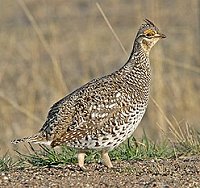Saskatchewan Specialties
356 species in 40 families

Provincial Bird Sharp-tailed Grouse
- Sharp-tailed grouse
- Ruddy duck
- White pelican
- Sprague’s pipit
- American wigeon
- House wren
- Horned lark
- Lesser scaup
- American bittern
Located in the prairie region of Canada, Saskatchewan is in the heart of North America, neighbouring the provinces of Manitoba to the east and Alberta to the west. To the south it borders the US states of Montana and North Dakota. To the north are the Canadian territories of Northwest Territories and Nunavut.
Known for its flat southern plains, over half of Saskatchewan is covered by the boreal forest and aspen parkland. Northern Saskatchewan also includes the the Lake Athabasca Sand Dunes, the largest active sand dunes in the world north of 58°. Southern Saskatchewan contains another area with sand dunes known as the “Great Sand Hills” covering over 300 square kilometres.
One-third of the province is cultivated land, and one-eighth is covered with water. The southern part of the province is relatively flat, with occasional valleys created by erosion from the glacial era.
Saskatchewan is clearly the province for grassland birds. Grasslands National Park in the south west portion of the province contains large colonies of black-tailed prairie dogs and their companions, burrowing owls. Migrating shorebirds also gather by the thousands at Last Mountain Lake.
The Cypress Hills, located in the southwestern corner, and the Killdeer Badlands are areas that remained unglaciated during the last glaciation period, and contain Saskatchewan’s highest point at 1,468 metres. Based on personal experience, birding in Cypress Hills is a real eye-opener. You’re liable to get grassland birds, mountain birds or forest birds, and often the range maps in the book don’t coincide with the bird you’re looking at.
Saskatchewan Web Links
Where Do You Want To Go Birding In Saskatchewan?



Your best bet is probably to check the website of the Fatal Light Awareness Program (FLAP) Canada at https://www.flap.org. Their site is loaded with information on window strikes and they sell a product to stop window collisions.
Hi there, we live with trees all around our house. I am looking for window protectors to keep birds from striking the glass. Do you know where I can find? Have seen pictures of large red dots affixed to the glass to warn birds. Thank you
It sounds like you have a dark-eyed junco in your yard. These members of the sparrow family are fairly common, and their plumage does vary. Have a look at https://www.allaboutbirds.org/guide/Dark-eyed_Junco/
We have a bird with a dark grey head and back and white underside. Can’t find out what type of bird we have in our backyard in Saskatoon, Saskatchewan
The first bird that came to mind was a juvenile grackle. Unlike their parents they are a mix of brown and black and are extremely noisy for their size, which is bigger than a robin. However they don’t have any kind of a crest on the back of their head. The only birds I know of with a crest (‘kind of pointy thing on the back of his head”) are blue jays. Any chance you could get a photo?
My husband saw a brown and black bird bigger than a robin but not as big as a crow. He was very noisy alittle like the ugly sound a crow makes. He had a kind of pointy thing on the back of his head and a forked tail which was quite long.We live in Christopher Lake and I don’t believe I have ever seen one like this. Are you able to identify this bird. Thank you.
Orange bird & brown markings is a Baltimore Oriole- just saw my first one today in Regina. Very unafraid of people!
The only thing that comes to mind is the Varied Thrush. There are not many birds in Canada that have orange feathers, and these would be the only possible winter visitors. Their winter colours are darker than their summer ones, so perhaps your birds just don’t match the one in the bird book. Varied thrush are a rare winter visitor, and usually you only see one at a time. If you could send a photo to birdcanada@gmail.com we’d be happy to take a look.
We have a few birds around here that we can not identify.
They are about the size of a small robin.
They are a bright orange with dark brown wings and markings.
They are not afraid of us as we can get quite close when they are in our black sunflower feeder.
I looked in the bird book and cannot find a bird exactly like them.
They sort of look like the Varied Thrush but are much a brighter orange and darker brown.
Could you help me identify this bird?
I have of photo of 3 birds feeding in a backyard last Saturday with temp. at minus 24.in Regina Sask. They very much look like robins. I do have a picture and would like to sent it to you to confirm. I do not have an e-mail address to send the picture to. Will you be able to confirm for me. Thanks
Bill.
We would like to know what the birding situation is like at Last Mountain Lake, Old Wives Lake and Chaplin Lake. Is the migration still happening or is it waning. Any information you can provide at these locations would be very much appreciated.
Thanks for pointing that out Bob. I’ve fixed my typo!
Your site is very interesting and informative.I was wondering about one thing you refer to
Lost Mountain Lake ,I was wondering if this was a misprint and perhaps it could be
Last Mountain Lake
Thank you
Bob Hanson